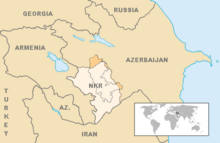Our website is made possible by displaying online advertisements to our visitors.
Please consider supporting us by disabling your ad blocker.
First Nagorno-Karabakh War


The First Nagorno-Karabakh War was a war that had happened since February 1988 until May 1994, over the small ethnic enclave of Nagorno-Karabakh in southwestern Azerbaijan, between the mostly ethnic Armenians of Nagorno-Karabakh backed by Armenia and Azerbaijan.[1][2][3] The war originates from 1918, when the World War I came to an end and the Ottoman Empire collapsed into independent states including Armenia and Azerbaijan, while the region was recognized as part of Azerbaijan.[1] Since then, Armenia has claimed it; Armenians have made many efforts to unify the region, although Azerbaijanis also have worked to protect their sovereignty as well as national identity.[1][4]
In February 1988, the war finally started, during the course of which both Armenia and Azerbaijan had utilized the legislatures to legitimize themselves while both caused pogroms as well as massacres against each other, with territorial loss of both sides alternated.[1][2][3] Furthermore, the Soviet Union, before its collapse in 1991, and Russia had been involved with this Nagorno-Karabakh War, which had an impact on the fate of the war.[3] The estimated death toll of the entire war is more than 30,000 on both sides.[5]
Not only Moscow but also European countries, the neighboring countries of both Armenia and Azerbaijan, the United Nations, as well as the United States, had made a variety of efforts to make a ceasefire come true.[3] However, there were conflicting interests among them and Nagorno-Karabakh itself therefore was not the most urgent matter for them.[3]
In the end, the war ended with a Russian-brokered ceasefire that had been in effect since midnight on 11 and 12 May 1994 until April 2 2016.[3][5]
- ↑ 1.0 1.1 1.2 1.3 Abilov, Shamkhal; Isayev, Ismayil (2016-12-01). "The Consequences of the Nagorno–Karabakh War for Azerbaijan and the Undeniable Reality of Khojaly Massacre: A View from Azerbaijan". Polish Political Science Yearbook. 45 (1): 291–303. doi:10.15804/ppsy2016022. ISSN 0208-7375.
- ↑ 2.0 2.1 Melander, Erik (May 2001). "The Nagorno-Karabakh Conflict Revisited: Was the War Inevitable?". Journal of Cold War Studies. 3 (2): 48–75. doi:10.1162/152039701300373880. ISSN 1520-3972. S2CID 57571913.
- ↑ 3.0 3.1 3.2 3.3 3.4 3.5 de Waal, Thomas. Black Garden : Armenia and Azerbaijan through Peace and War. ISBN 978-0-8147-7082-5. OCLC 1242726645.
- ↑ Harutyunyan, Ani (2017-02-14). "Two state disputes and outside intervention: the case of Nagorno–Karabakh conflict". Eurasian Economic Review. 7 (1): 69–93. doi:10.1007/s40822-017-0064-2. ISSN 1309-422X. S2CID 157009903.
- ↑ 5.0 5.1 K., Chhabra, Amit. How to Mediate an Enduring Peace for Nagorno-Karabakh. OCLC 1305978560.
{{cite book}}: CS1 maint: multiple names: authors list (link)
Previous Page Next Page
Eerste Nagorno-Karabach-oorlog AF حرب مرتفعات قره باغ الأولى Arabic Guerra del Altu Karabakh AST Birinci Qarabağ müharibəsi AZ بیرینجی قاراباغ ساواشی AZB Карабахская вайна BE Карабаская вайна BE-X-OLD Нагорнокарабахски конфликт Bulgarian প্রথম নাগর্নো-কারাবাখ যুদ্ধ Bengali/Bangla Brezel Nagorno-Karabac'h BR


